A narrative is a message, a story about a specific event in its time sequence. Now that we know what a narrative is, let's talk about its characteristics. A special feature of the narrative is that it talks about actions that follow one another. Narrative texts are characterized by the presence of a beginning (the beginning of the event), a development of the event, and a denouement (the end of the event). The narration can come from both the third person (the author's narration) and the first - the narrator is designated by the personal pronoun I.
The concept of “narrative technique” is often used in narratology (the theory of storytelling) and is used to designate a set of narrative techniques used by the author while writing literary works.
Functional and semantic types of speech
All our speech can be divided into the following types: narration, description, reasoning. Each of them has characteristic features. Let's look at what description, narration, reasoning are, and how they differ.
Description is an image of a certain phenomenon, person, object, by listing and revealing its main features. For example, when describing a person, we point to such features as height, eye and hair color, posture, gait, smile, age, etc. The description of the room will consist of such features as size, furniture features, wall design, number windows, etc.
Reasoning is a verbal explanation, presentation, confirmation of a certain thought. The composition of this type of speech is as follows: thesis, that is, the idea that needs to be substantiated or refuted; then follows the justification of the thought, which contains arguments, evidence, which is supported by examples; conclusion, conclusion.
Let's talk about storytelling in more detail.
Narrative Features
In general, any narrative text tells a story. At the same time, the story can be presented sequentially from the very beginning to the very end, or it may contain rearrangements of events. To understand what a narrative text is, you need to remember that such a story may omit some events, or contain memories of past events or hints at future ones.
The time it takes to tell a story is related in different ways to the time it takes for the story to happen: to exceed it, to be less than it, or to be equal to it. Different combinations of the relationships between the two tenses form narrative movements: scene, pause, ellipsis and summary. Each of these movements is characterized by a certain pace of the narrative, and the alternation (or ratio) of movements is responsible for the narrative rhythm.
Getting ready for the Unified State Exam
TYPES OF SPEECH
Task 21.
Mikheeva Marina Aleksandrovna,
teacher of Russian language and literature,
OGKOU KSHI "Kolpashevo Cadet Corps"
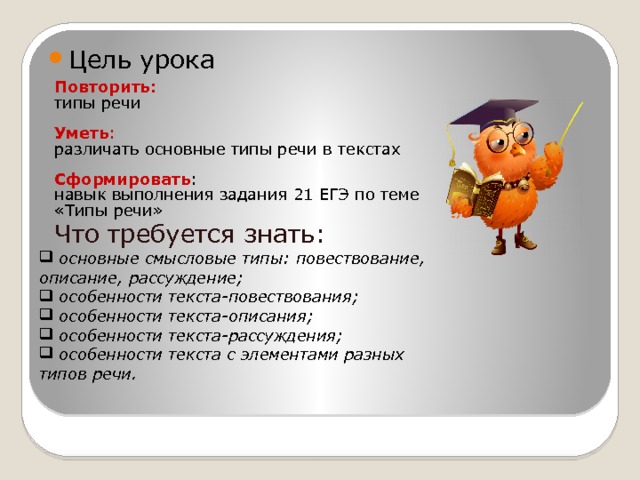
- The purpose of the lesson
Repeat:
types of speech
Be able to :
distinguish the main types of speech in texts
Form :
skill in completing task 21 of the Unified State Exam on the topic “Types of speech”
What you need to know:
- basic semantic types: narration, description, reasoning;
- features of the narrative text;
- features of the descriptive text;
- features of the argumentative text;
- features of text with elements different types speech.

REMEMBER:
All texts are divided into three semantic types: narration, description, reasoning.
Narration –
this is a type of speech in which narrated, narrated about any events in their time sequence. Events in the story replace one another .
Narrative composition:
- the beginning of the action (the beginning of events);
- development of action;
- climax (the highest tension of the action);
- denouement.

Features of narrative text
- a large number of verbs that convey movement, action;
- in a narrative text we can imagine the movement of action in time and space, therefore there are many adverbs of place and time in it;
- narration is characteristic of many styles (colloquial, artistic, scientific).
Example of a narrative text
I actually saw a white cloud at the edge of the sky, which I initially mistook for a distant hill. The driver explained to me that the cloud foreshadowed a snowstorm. I heard about the blizzards there, that entire carts were covered in them. Savelich, in agreement with the driver’s opinion, advised him to turn back. But the wind did not seem strong to me; I hoped to get to the next station in time and ordered to go quickly. The coachman galloped off; but he kept looking to the east. The horses ran together. Meanwhile, the wind became stronger hour by hour.
(« Captain's daughter"A.S. Pushkin)

Description –
this is a type of speech in which described anything depicted some kind of reality. The description can list both general and specific characteristics, and express impressions about someone or something.
What can be described?
- portrait, that is, a description of a person’s appearance, his condition;
- landscape, that is, a description of nature, a specific corner of nature, or the state of nature in general at a given moment;
- interior, that is inner space premises;
- thing, for example, a toy;
- an animal, for example, a beloved dog.
Description composition
- general idea of the subject of description
- individual characteristics of the subject of description
- may include the author's assessment, conclusion, conclusion

Features of the text - descriptions
- leading parts of speech - nouns, adjectives, participles;
- verbs are mainly used in the imperfect form, as they help convey the static, timeless nature of the description. Something is described at a given moment in time;
- sentences are often simple; incomplete and nominal sentences can be used;
- The description provides answers to the questions: what is it like? where is it? (right, left, nearby), what is it like here? how does he feel? (good, bad, fun), what sensations and feelings does he have? (joyfully, cheerfully)
Example of a narrative text
His appearance seemed remarkable to me: he was about forty, average height, thin and broad-shouldered. There was a streak of gray in his black beard; alive big eyes so they ran. His face had a rather pleasant, but roguish expression. The hair was cut into a circle; he was wearing a tattered overcoat and Tatar trousers.
(“The Captain’s Daughter” by A.S. Pushkin,
description of Emelyan Pugachev)
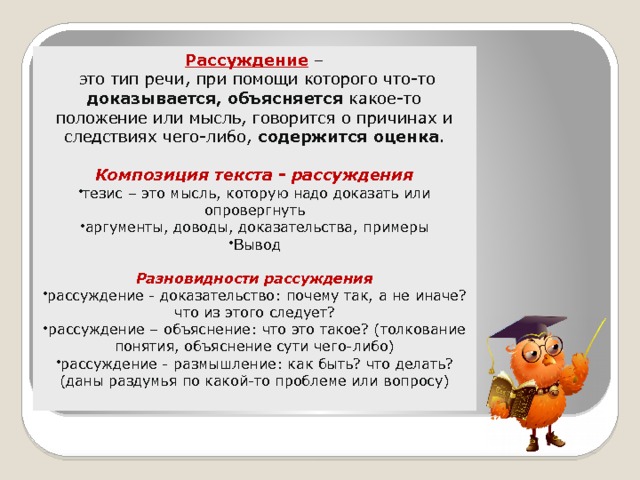
Reasoning –
is a type of speech by which something proven, explained some position or thought, talks about the causes and consequences of something, contains an assessment .
Text composition - reasoning
- a thesis is an idea that needs to be proven or refuted
- arguments, reasons, evidence, examples
- Conclusion
Types of reasoning
- reasoning - proof: why is it this way and not otherwise? what follows from this?
- reasoning - explanation: what is it? (interpretation of a concept, explanation of the essence of something)
- reasoning - thinking: what to do? what to do? (thoughts are given on some problem or issue)

Features of the text - reasoning
- Take up a lot of space introductory words, which help to consistently present thoughts, indicate the connection of thoughts (firstly, thus, so, therefore)
- Quite complex syntax (presence of isolated members, introductory constructions, complex sentences)
An example of a reasoning text
My thoughts on the road were not very pleasant. My loss, at the prices at that time, was significant. I could not help but admit in my heart that my behavior in the Simbirsk tavern was stupid, and I felt guilty before Savelich. All this tormented me.
"The Captain's Daughter" by A.S. Pushkin

It should be remembered that the boundaries between types are arbitrary. It is rare that a text can be classified into only one specific type. Combinations of speech types are much more common in the most various options: description and narration; description and reasoning; description, narration and reasoning; description with elements of reasoning; narration with elements of description and others.
These are the types of tasks that often appear on the Unified State Exam: you need to prove the correctness of a statement that names a combination of speech types.
For example:
In sentences 2-8 - reasoning with elements of description.
In sentences 17-25 there is a description with elements of reasoning.
Carrying out a task № 21 , remember what the features of each type of speech are, find them in these sentences.
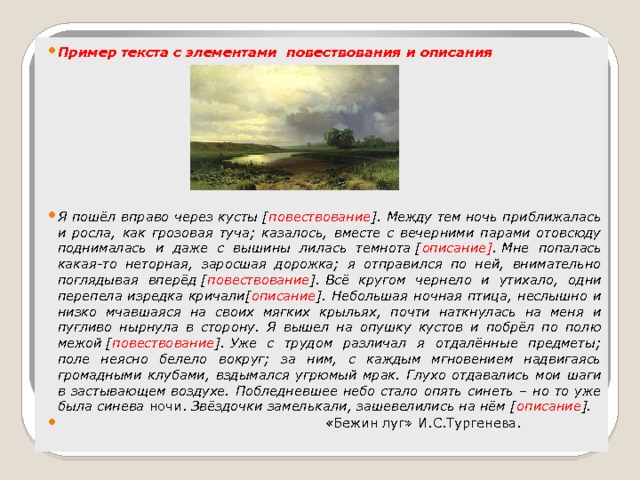
- Example text with narrative and descriptive elements
- I went right through the bushes [ narration ]. Meanwhile, the night was approaching and growing like a thundercloud; It seemed as if, along with the evening vapors, darkness was rising from everywhere and even pouring from above [ description] . I came across some kind of unmarked, overgrown path; I walked along it, carefully looking ahead [ narration ]. Everything around turned black and died down, only the quails screamed occasionally[ description ]. A small night bird, silently and low rushing on its soft wings, almost stumbled upon me and timidly dived to the side. I went out to the edge of the bushes and wandered across the field between [ narration ]. It was already difficult for me to distinguish distant objects; the field was vaguely white around; behind it, looming in huge clouds every moment, rose the gloomy darkness. My steps echoed dully in the frozen air. The pale sky began to turn blue again - but it was already blue nights. The stars flickered and moved on it [ description ].
- “Bezhin Meadow” by I.S. Turgenev.
Reasoning means consistently expressing your thoughts, giving evidence.
Text-reasoning- this is a text that explains something, draws conclusions, a text that answers a question Why?
The roots of a tree perform two services. First, they feed and nourish the tree with food that they suck from the ground. Secondly, they anchor the tree to the ground. Take away the roots of a tree and it dies.
This is an argumentative text, since it answers the question: why do trees need roots?
Why do we love fairy tales or why we shouldn’t be late for classes, why don’t elephants fly? By answering these questions, we express our opinion and provide evidence of this opinion, which means we are building a text-reasoning.
The text-reasoning consists of three parts:
2. Proof
Thesis- statement that is needed prove.
Eg:
Dolphins are animals, not fish. A dog is man's friend. I like to go to school.
The thesis can begin with the words:
I think that….. It seems to me that….. I believe that…. In my opinion…..
For example:
I believe that The multiplication table just needs to be learned.
I think that When I grow up, I will become a doctor.
In my, you need to do exercises in the morning.
The most commonly used thesis questions are: Why? For what? When? Did you know?
For example:
Why Lion is the king of the animals? For what Does the cuckoo throw eggs into other people's nests?
Did you know that the hippopotamus has almost no enemies?
Proof- the second part of the text-reasoning, words are used for it Firstly Secondly Thirdly.
In writing, these words are separated by commas. For example:
I like to go to school. Firstly
Secondly, I'm interested in learning. Third, I have many friends there.
Thesis - I like to go to school, proof - Firstly Secondly Thirdly, these words are separated by commas.
Conclusion- this is the result of the argument. Most often, the conclusion is attached to the proof with the words: therefore, therefore, therefore, therefore, it can be argued, therefore I believe that...
In writing, all words except the word “therefore” are separated by a comma. For example:
I like to go to school. Firstly, I really like our teacher.
Secondly, I'm interested in learning. Third, I have many friends there.
That's why I love going to school.
“This is why I love going to school” is the conclusion. You can use words from the thesis statement in your conclusion.
Exercise 1.
Read the text, determine the thesis, evidence, conclusion.
Who is the strongest in the world?
You will say: “whale” or “elephant”. You're wrong the strongest living creature is the ant.
Firstly, the ant is capable of carrying weights ten times its own weight.
Secondly, an ant family is building a huge house-city, which goes deep underground.
Therefore, the strongest in the world is the ant.
Task 2.
Read the sentences. Arrange them in the right order to make a text-reasoning.
That's what he's been called ever since. The fact is that he is very gluttonous.
Why was the sparrow called that?
By arranging the sentences in the right order, we get the text-reasoning:
Why was the sparrow called that?
The fact is that he is very gluttonous.
It often destroys not only insects, but also damages the crop.
“Beat the thief!” - the peasants shouted when they saw how the sparrows were destroying their crops.
That's what he's been called ever since.
Task 3.
Insert appropriate words to create a reasoning text.
A dog is _____ of a person _______, it saves people in the mountains, during fires _______, and helps in work. A dog can be _________, _______ and _________. And finally, she is just a great friend __________ people erect monuments to dogs, write about them ______.
One option could be:
A dog is man's friend. Firstly, it saves people in the mountains during fires. Secondly, it helps with work. A dog can be a shepherd, a border guard and a bloodhound. And lastly, she is just a great friend. That’s why people erect monuments to dogs and write books about them.
The conclusion in a reasoning text may sometimes be missing.
1. I’m thinking about a question that needs to be answered.
2. I am writing a thesis.
3. I compose evidence using the words “firstly”, “secondly”, “thirdly” and others.
4. I draw up a conclusion using the words “therefore”, “therefore”, “therefore” and others.
5. I write down the text.
6. I check the text.
Homework
1. What questions does the reasoning text answer?
2. What parts does the argumentative text consist of?
3. What words are used to connect parts of the text-discussion?
Narration, in contrast to a description, is an image of events or phenomena that do not occur simultaneously, but follow each other or condition each other. Apparently, the shortest example of a narrative text in world literature is Caesar’s famous story: “I came, I saw, I conquered.” It clearly and accurately conveys the essence of the story - this is a story about what happened, happened.
Narration reveals closely related events, phenomena, actions as objectively occurring in the past. That is why the main means of such a story is the perfect past tense verbs that replace each other and name actions. Sentences of narrative contexts do not describe actions, but narrate about them, that is, they convey the event itself, the action.
Narration is closely connected with space and time. The designation of a place, an action, the name of persons and non-persons performing the actions, and the designation of the actions themselves are the linguistic means with the help of which the narrative is told.
Stylistic storytelling functions diverse, associated with individual style, genre, subject of the image. The narrative may be more or less objectified, neutral, or, on the contrary, subjective, permeated with the author's emotions.
One of the objectified varieties of narration is message, distributed in the media. An example is the article “A terrorist with a screwdriver hijacked a train” from the Komsomolskaya Pravda newspaper:
At five in the morning the third carriage of the Vladivostok-Novosibirsk train was sleeping peacefully. And in one compartment real hostilities have already unfolded. When the train approached Zima station, one of the passengers woke up three neighbors and announced that he had taken them hostage. To be convincing, he threatened with a screwdriver. A 40-year-old fellow traveler from Irkutsk tried to resist, but the invader poked him with a screwdriver. The others immediately fell silent. Meanwhile, the terrorist put forward his demands.
Through closed door he shouted that he wanted to convey something important to the FSB. There were no security officers on the train, but officers from the line police department were waiting for the train at the Zima station. Sleepy passengers were evacuated from the carriage. They tried to negotiate with the invader for twenty minutes. But the man behaved inappropriately. He was nervous and threatened. The operatives began to fear for the lives of the hostages. And then the senior escort squad - a police warrant officer - opened fire. The terrorist died on the spot from his wound.
An hour later the train departed safely along the route. The incident is being investigated by the Nizhneudinsk Transport Prosecutor's Office. A criminal case has been initiated under Article 206 of the Criminal Code “hostage-taking”.
Example subjective narration can serve as the story of the hero of the story A.S. Pushkin's "Shot" about a duel with the count. The narration is told in the first person, all events are passed through the author's perception. Silvio involuntarily concentrates his attention on those key moments that made a special impression on him, hurt his pride, insulted him, etc.:
It was at dawn. I stood at the appointed place with my three seconds. I waited with inexplicable impatience for my friend. I saw him from afar. He walked on foot, with his uniform on his saber, accompanied by one second. We went to meet him. He approached, holding a cap filled with cherries. The seconds measured out twelve steps for us. I was supposed to shoot first: but the excitement of anger in me was so strong that I did not rely on the fidelity of my hand and, in order to give myself time to cool down, I conceded the first shot to him; my opponent did not agree. They decided to cast lots: the first number went to him, the eternal favorite of happiness. He took aim and shot through my cap. The line was behind me. His life was finally in my hands; I looked at him greedily, trying to catch at least one shadow of concern... He stood under the pistol, choosing ripe cherries from his cap and spitting out the seeds, which flew to me. His indifference infuriated me. What good would it do me, I thought, to deprive him of his life when he does not value it at all? An evil thought flashed through my mind. I lowered the gun. “It seems you don’t care about death now,” I told him, “you would like to have breakfast; I don’t want to disturb you...” “You don’t bother me at all,” he objected, “if you please, shoot yourself, but however you wish: your shot remains behind you; I am always ready at your service." I turned to the seconds, announcing that I did not intend to shoot today, and that was how the fight ended.
With all the variety of specific narrative texts, we can highlight some of the most typical ways of constructing this type of text.
Rhetorics offer the narrator several typical narrative patterns.
1. The beginning of the story. Possible options:
address to the addressee:
Do you know what Ukrainian night is?..(Gogol);
general idea of the story:
In our stinking days, even in the silence of the Merrekul sands, there is no escape from the grimaces and sores of our native politics.(Leskov);
a generally accepted truth expressed in aphoristic form:
It’s hard sometimes to be a Russian person(Taffy);
place, time, character:
In very ancient years, ancient times, there was in some humble kingdom a wise king named Dobrokhot(Leskov).
2. The middle of the story. The structure of the narrative itself may be different. You can follow the natural order of events. You can start with some unusual, bright moment, which was not at the beginning, but in the middle or at the end of the event, etc. (cf. the composition of the novel by M.Yu. Lermontov “A Hero of Our Time”).
The specific composition depends on the specific tasks that the author sets for himself. But in any case, rhetoricians recommend “increasing” the degree of interest of the addressee, moving towards the climax of the story, which completes the middle of the story.
3. End of the story usually contains the resolution of the story. It, according to the recommendation of rhetoricians, should be told in such a way as to correspond to the beginning and middle. After the denouement, a “moral thought” may follow, or a conclusion from the entire narrative (cf. morality of fables).
Thus, when composing your own stories, you must follow certain rules. The most common of them are the following:
- simplicity;
- clarity;
- brevity;
- credibility;
- a gradual increase in “interest” until the climax and denouement in conclusion.
Today we will talk about narrative text. Let's look at the first example. Let's read the text:
Once they planted a duck egg. The chicks have hatched. The duck took them to the pond. The chicken also went with them. The ducklings go into the water, and he follows them. It’s good that there were guys on the shore. We barely saved the chicken(Fig. 1) .
Rice. 1. Chicken and duckling ()
What is the text talking about? This text tells how a chicken egg was placed on a duck and what came of it. What question can be asked about this text? Can I ask you a question what happened? Before us is a narrative text.
Text-narration is a text that tells about the actions of someone or something. You can ask a general question about it what happened?
A narrative text can be compared to film frames that follow one after another. Let's look at what parts a narrative text consists of. In the narrative text there are three parts :
2. Main part
3. Conclusion
Let's look at the construction features of each part. The text can begin with one or two sentences, where we indicate where, with whom, when the events occurred. For example:
One summer, the guys and I...
This happened in early spring...
The main part includes the beginning of the event, the development of the event, and the end of the event. The main part is characterized by the following words: suddenly, suddenly, then, then, finally.
In the final part it is necessary to indicate how the story ended. The final part can consist of one sentence. Each part of the narrative text is written on a red line.
You might think that narrative text is only used for stories. However, narrative text can also be used as:
1. instructions;
2. letter;
3. note;
This is a narrative text because it talks about an apple tree and you can ask a question about the text what happened?
Subject of the text: apple tree.
The main idea: the apple tree was saved.
You can title the text like this: Saving the apple tree.
Let's divide the text into semantic, complete parts. Let's define the beginning, the main part and the conclusion.
Let's check.
Start: A small apple tree grew near the house.
Main part: A strong wind blew up. He began to twist and break the tree. Dima brought stakes. The boy tied up an apple tree.
Conclusion: The apple tree was saved.
Each part must be written on a red line.
Let's read the text and arrange its parts in the right order. Let's determine the type of text, its topic and main idea.
The boy has good friends! Sasha got sick. He's bored. But then Tanya and Seryozha came to him. They talked cheerfully about school affairs. Sasha was glad the guys came(Fig. 3) .
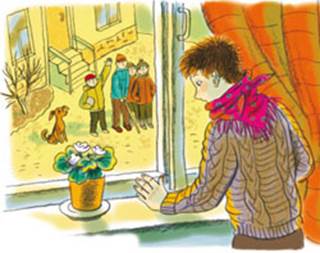
Rice. 3. The boy is sick ()
Let's check.
Sasha got sick. He's bored.
But then Tanya and Seryozha came to him. They talked cheerfully about school affairs. Sasha was glad that the guys came.
The boy has good friends!
Type of text: narrative text, because you can ask a question about the text what happened?
Subject: The boy got sick.
The main idea is expressed in the last sentence:
The boy has good friends!
Heading options:
Sasha's friends. Good friends.
Let's read the proposals. Let's put the sentences in order and name the parts of the text.
Meeting with a lynx (Fig. 4)
We're back home. One Sunday my friends and I went to the forest for a ski trip. These were the paw prints of a large cat. She was lying on a thick branch. Suddenly my friend noticed footprints. And here is the lynx itself. It was dangerous to go further.
Let's check.
Meeting with a lynx
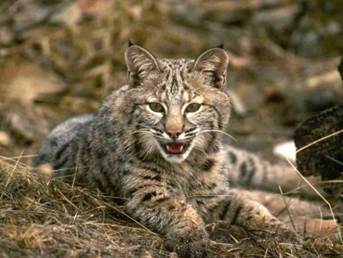
Parts of text:
Start: One Sunday my friends and I went to the forest for a ski trip.
Main part: Suddenly my friend noticed footprints. These were the paw prints of a large cat. And here is the lynx itself. She was lying on a thick branch.
What part of speech do you think words are most often found in narrative texts? These are verbs. Without verbs we would not be able to talk about what happened. Verbs are the supporting words for a narrative text.
Let's look at the pictures, compose a narrative text using these verbs, and title the text.
let's go, ran
saw, snorted, spread out
got scared and ran away
Correct answer:
Once the guys went into the forest. The puppy ran after them.
Suddenly the puppy saw the hedgehog and barked. The hedgehog snorted and spread his needles.
The puppy got scared and ran away(Fig. 5) .

Rice. 5. Hedgehog and puppy ()
The text could be titled: Puppy and hedgehog. Meeting.
To write a narrative text, you need to be able to draw up a plan. Let's find out how to do this.
Let's read the text and divide it into semantic parts.
By the sea
There was a storm at night. A strong wind blew. By morning the storm had subsided. Natasha and Seryozha went to the sea. Natasha picked up a small crustacean from the sand. The waves washed him ashore. He moved his paws weakly. The girl threw the crustacean into the water. He tumbled in the green water and swam away. There was a fish swimming on its side in the puddle. Seryozha caught her and released her into the sea. On this day, children saved many sea animals(Fig. 6) .
(According to G. Snegirev)

Rice. 6. Seashore ()
Let's check.
Start. What happened at night?
There was a storm at night. A strong wind blew.
We can title the first part “ storm at night."
To title the main part, you need to answer the questions: when did the storm subside? In the morning. Where did Natasha and Seryozha go? To sea. Who did Natasha save? crustacean. Who did Seryozha save? Fish. Let's title this part "Saving sea animals."
Conclusion. How did the story end?
On this day, the children saved many sea animals.
This part can be titled "Saviors". So, we have the following text plan:
1. Storm at night.
2. Rescue of sea animals.
3. Natasha and Seryozha are great.
Using this plan, retell the text.
We learned that the narrative text tells about some event. You can ask a question about this type of text what happened?
Bibliography
1. Klimanova L.F., Babushkina T.V. Russian language. 2. - M.: Education, 2012
2. Buneev R.N., Buneeva E.V., Pronina O.V. Russian language. 2. - M.: Balass, 2012
3. Ramzaeva T.G. Russian language. 2. - M.: Bustard, 2013
3. Website rataiko.school139.edusite.ru ()
Homework
1. Klimanova L.F., Babushkina T.V. Russian language. 2. - M.: Education, 2012. Part 2. Do the exercise. 184, 185 P. 135.
2. Read the text. Choose a title for this text, draw up a text outline.
The red sun floated into the sky and began sending its golden rays everywhere.
The first ray flew and hit the lark. The lark perked up, fluttered out of the nest, rose high, high and sang its silver song: “Oh, how good it is in the fresh morning air! How fun!”
The second beam hit the bunny. The bunny twitched his ears and hopped merrily across the dewy meadow: he ran to get some juicy grass for breakfast. (K. Ushinsky)
3. *Using the knowledge gained in the lesson, compose a text-narration based on the picture. Give it a title, make a plan.




